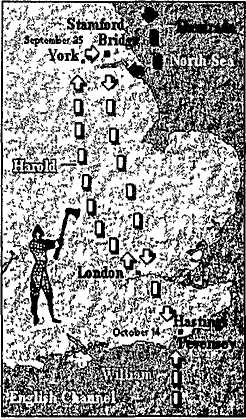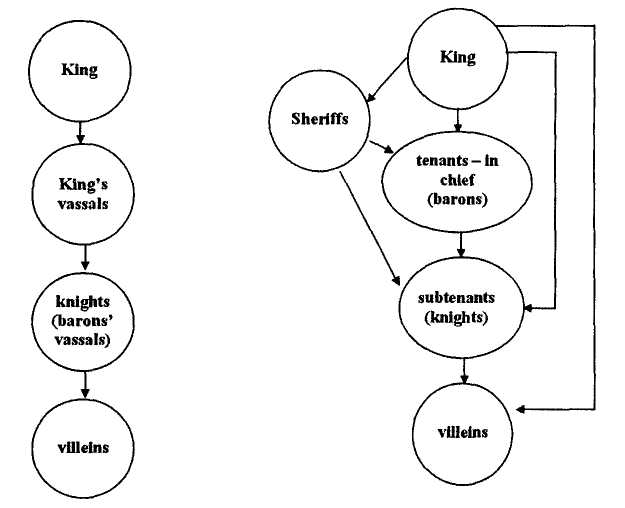
- •Early britain
- •Prehistoric Britain
- •Cultural Focus: Stonehenge
- •Celtic Invasions
- •Cultural Focus: The Druids
- •The Roman Conquest and Occupation
- •Early History
- •The Romans and the Celts
- •Early History
- •The Fall of Britannia
- •The Anglo-Saxon Kingdoms
- •The Anglo-Saxon Culture
- •The scandinavian invasion First Raids and Battles
- •Danelaw
- •Cultural Focus: King Alfred the Great
- •Restoration of the Saxon Kings
- •The norman conquest The Norman Invasion
- •The House of Normandy
- •The Effect of the Norman Conquest
- •Cultural Focus: The Canterbury Tale
- •Magna Carta. The First Parliament
- •Cultural Focus: Prince of Wales
- •The Wars of the Roses
- •England in the 16th century. The tudor monarchy
- •Henry VII
- •Henry VIII — Beginning of the Reign
- •Henry VIII and the Reformation
- •Edward VI
- •Bloody Mary
- •Mary, Queen of Scots
- •Elizabethan Times
- •Cultural Focus: English Renaissance
- •England in the 17th century. The stuart dynasty
- •James the First
- •Charles the First
- •Civil Wars. Execution of the King
- •Republic of Commonwealth
- •The Restoration Period
- •Glorious Revolution
- •William III
- •The Union with Scotland
- •Building the Empire
- •George III. The American Revolution
- •The Industrial Revolution
- •4) Negotiate, negotiable, negotiator, negotiation
- •7) Stipulate, stipulation
- •8) Smuggle, smuggler, smuggling
- •Britain in the 19th century
- •The Period of Napoleonic Wars
- •Britain after the Napoleonic Wars
- •The Victorian Age
- •British Empire
- •Britain in the first half of the 20™ century
- •The Beginning of the Century
- •Fighting for the Vote
- •Death of Edward VII. King George V
- •The First World War
- •Britain after World War I
- •Britain in World War II: 1939-1943
- •The Crown in World War II
- •Britain in the second half of the 20th century
- •The Commonwealth
- •Domestic Affairs
- •Cultural Focus: Welfare in Britain
- •Britain and Her European Neighbours
- •The Royal Family Today
- •1. Geographical factors:
- •2. Historical factors:
- •Bibliography
The norman conquest The Norman Invasion
The 9th century saw two parallel conquests — while one branch of the Northmen was plundering England, another branch conquered the northern coast of France. They got the name "Normans" — a variation of the word "Northmen", the territory they settled down on was later called Normandy.
Normans adopted the French language, manners, customs and the way of life. They acknowledged the King of France as then" overlord, but the Duke of Normandy was as strong as the King himself and the domain of the Duke was even bigger. The Duchy of Normandy coined its own money, made its own laws, had its own courts and castles. There was the best-trained cavalry in Europe, which could wage wars against other dukes and even against the King of France.
The years of Danelaw in England brought it to close relations with Normandy. In 1042, after the death of Canute and his sons, Edward, the son of Aethelred the Unready, was brought from Normandy to become the King of England.
Being more French than English, Edward grew in a monastery and cared more for quiet, learned life. Edward built many cathedrals all over the country; the Westminster Abbey was built and became a royal residence in his reign.
When Edward died early in 1066, getting posthumously the title of "the Confessor", the Witenagemot declared his relative the Anglo-Saxon Earl Harold King. William, the Duke of Normandy, who was cousin to Edward the Confessor, claimed that England belonged to him and began preparations for a war.
William got the Pope of Rome on his side, promising to strengthen Pope's power over the English Church. He also called upon all Christian warriors of Europe promising them land instead of pay. Many sailing boats were built to carry the army across the Channel.
When the news of the intended invasion came to Harold, he led his army to Kent where the enemy was most likely to cross and waited all through the summer of 1066. Early in September Harold learned that William's ally the King of Norway had taken York. While Harold was defeating the invaders at Stamford Bridge not far from York, William landed in the south of England. Harold hurried back and on October 14 the decisive battle took place at Hastings. Though the Saxon army fought bravely it was defeated and Harold was killed in battle.

Immediately after that victory William and his army proceeded to London and took it without giving the rebellions Londoners any chance to get reinforcements. William was crowned King on December 25 as William I. He ruled England for 21 years (1066—1087) and established the Norman Dynasty.
Task 1. Speak about the Norman invasion using the map.
The Reign of William the Conqueror
The first five years of William the Conqueror's reign were really difficult — numerous rebellions against Norman rule rose in different parts of the country. By 1071, the subjugation of the country was completed. As William regarded himself the lawful successor of the Crown, he kept the main institution as they were — the King's Council and sheriffs were preserved with some differences. The sheriffs grew in importance as royal agents and at the end of William's reign there were about 20 feudal tenants-in-chief.
William granted the conquered land to Normans, who swore an oath of allegiance to him and became his vassals. The vassals of the barons also had to swear to William directly and support the King against all his enemies, both foreign and domestic.
The estates granted by William were scattered about the country so that great nobles couldn't collect their forces against the royal power. The great earldoms of Northumbria, Mercia and Wessex, which had been established in the reign of the Danish King Canute, were abolished. Instead the country was divided into counties (the Norman name for shires) ruled by sheriffs, who administered justice, collected taxes to the royal treasury and were responsible for gathering army.
The Witenagemot was replaced by the Great Council, which advised the King and acted as King's Supreme Court, presiding over all serious trials.
King's laws were in force everywhere — King owned all woods, which made one third of the country, only the King had the right to coin the money, no baron was allowed to make wars — all men had to keep "the King's peace".
Twenty years after the Conquest William I organised the registration nicknamed "Doomsday Book" — so thorough and inquisitive were King's agents, that there was no possibility to conceal anything from them as on the supposed Day of the Final Judgment. "Doomsday Book" gave the King a clear idea of the economic state of the country and exact value of the estates, thus consolidating the position of the conquerors.
After the registration William imposed heavier taxes, aggravating feudal exploitation and hastening the process of turning the free peasants into serfs.
Task 2. Speak about European and English forms of feudalism, using following schemes and explanations. The arrows on the schemes show the power of one people over the others.
European feudalism English feudalism

Feudal society was based on suzerain-vassal relationship — the vassal got from suzerain feud — the land to rule on. King was the owner of the country's land, he gave it to feudal lords and they — to their vassals.
In Europe the system was unstable as feuds were ruled by the same lords and their families for many years. King's vassals gained more and more power which led to civil wars.
Sometimes the same vassal had 2 feuds from different lords. Often — in different countries. William the Conqueror was the King of England and the vassal of the French King (as the Duke of Normandy).
In England King granted the land to his tenants-in-chief and got from them military services and customary duties. The central power was represented by sheriffs, who were stronger than any baron on the territory.
